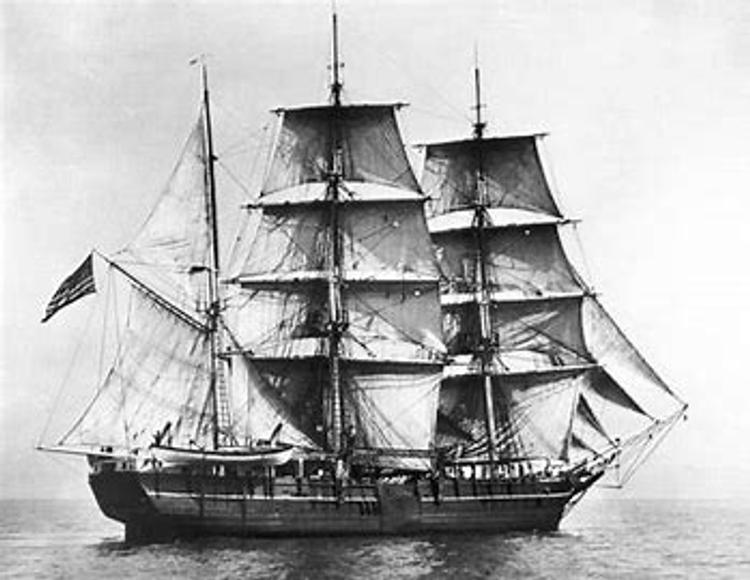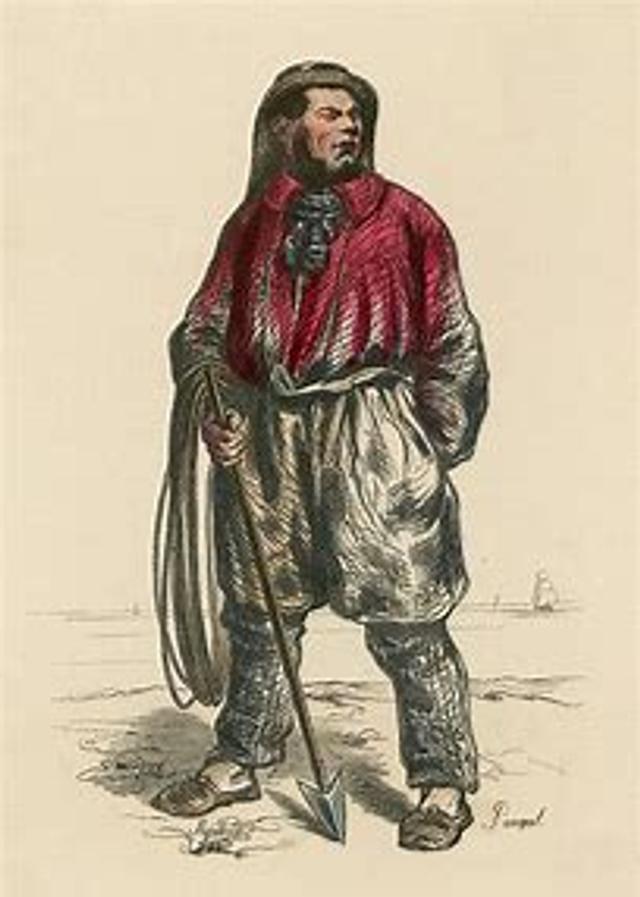Perseverant
Vessel Name: Perseverant
Five unnamed crew members
Died of scurvy, buried on Dirk Hartog Island
15 March 1841
M Desally, second mate and five unnamed crew members
Drowned in a storm; bodies not recovered
15 June 1841

French whaler carrying whaleboats

Perseverant camp site

French whaler
Perseverant was a French whaler built in the port of Binic in the north of France. She was registered there as number 60 of 1836. She was built for Louis Marie and was described as the belle of their large fleet. She weighed 335 tons burthen and had a draft of 10 feet [3.05 metres]. Perseverant was built for whaling; her oak hull was copper-sheathed.
Whalers signed on for three years and knew that they would not see home or loved ones again in a long time. The ship's boys could be as young as 12 or 13 years, from poor families who were happy their sons could earn a living, even though whalers were a rough and ready crew to grow up in and their lives could be forfeit with the dangers of the sea.
Although conditions on board were strict, there were some incentives for men to sign on to a whaling vessel. Whalers were paid an up-front fee when they signed on. That money usually went to the wife or mother of the whaler, as it was all they had until the whaler came home. There were terms and conditions for provisions, the quality and quantity of rations, and amounts paid for sickness, disability or death. Officers and the surgeon had 300 francs in advance, while the ship’s boys had 60 francs. Whalers were paid by share of the catch.
Perseverant’s captain was 28-year-old Yves Marie Duval.He had earned his Master Mariner certification [Capitaine au long cours] and this was his first command. He had cut his teeth in the south seas whaling fishery. Captain Duval had three officers, Jean Marie Chau, a surgeonand 28 crew:
Captain Yves Marie Duval, captain – ¼ share
Le Cognac, Chief mate
M Desally, 2nd mate
Estrade, 3rd mate
Jean Marie Chaumont, surgeon
Alix Briand, harpooner, share
Jean Claude Orhan, sail maker – 1/150 share
Ship’s boys – 1/300 share
20 general crew members assigned to positions on the ship and in the whale boats
Perseverant had been at sea for a long period of time whaling around the southern coast of Western Australia. She had caught only seven whales, and Captain Duval decided to layover at Albany for six weeks while the crew rested and made repairs to both boat and equipment.
Replenishing food stores was difficult; four of the crew had scurvy. A harpooner deserted and was not found. Another man had a leg wound which prevented him from working. The decision was made to sail to the northwest to hunt whales in their breeding grounds. Captain Duval traded French brandy to Thomas Sherratt, a trader/smuggler for fresh produce, sheep and pigs.
They reached Shark Bay late in February 1841. A medical tent was established ashore on Dirk Hartog Island, and the surgeon moved eight men into it for care. The Perseverant was anchored five miles off the island, outside the reef. Some of the crew were landed on the island to hunt turtle and any other fresh food they could find.
By mid-March, the weather had not improved, and five of the sick men died. They were buried on the island, although there are no markers, and the bodies have not been located by archeologists.
The wind blew up and the tide ran more ferociously. The storm lasted three days. Eventually Perseverant started dragging her anchors, and the wind was blowing harder. Captain Duval took some men and cut down the mizzen mast, hoping to slow the boat and stop her from grounding. It slowed her down, but she struck a sand bar and bilged on the second day at 7am.The rudder shore off and took the stern post with it.
Water quickly filled the hold and part of the steerage between decks. The crew let the anchor chain veer out and jettisoned anything that was not essential, but Perseverant did not rise at all. She was thoroughly grounded. Realising the boat was wrecked, the crew started to bring their stores ashore. They were no longer waiting on the weather and the health of the sick. They were marooned on Dirk Hartog Island. The crew abandoned the boat and made camp on the island.
By 30 May 1841, the crew had been on Dirk Hartog Island for 10 weeks, with no sighting of a vessel, and no change in their situation. The general feeling was one of desperation. Their health was declining. the decision was made to man the whale boats and leave the island. The men packed up their remaining food and divided it between the small boats and gathered what remained of their personal possessions.
As the weather cleared up, the men discussed their safest route. They read the winds and tides and settled on Java, a 600 mile [965 kms] voyage. In the first boat was Captain Duval, Jean Chaumont, and four crew members. The second boat had Le Cognac, and four crew members. The third boat carried Desally and four men, and the fourth boat had Estrade and four of the crew. On 6 June they shaped their course and set off from the island.
As luck would have it, another storm blew up on the 15 June. As the storm increased, the boats lost sight of each other. Suddenly Desally’s boat capsized, and the five men were thrown into the water. The other boats could hear the men calling for help, but could not see them, and had little control of their direction in the howling winds.
Before the storm abated, one of the crew from Estrade’s boat was lost. He appears to be one of the crew in poor health. The loss of those six men was disturbing, and the remaining whalers resolved to do their best to get to safety.
By 26 June Estrade’s whale boat was at Java Head (west end of Java) when it came into contact with the British ship Eliza, with Captain McCarthy in command. The men were taken to St Helena, part of the British territory in the south Atlantic, west of Africa.
Captain Duval and his little band of men reached the northeast end of Java. They traded the whaleboat for arms and then traded their arms for food. They made their way overland to Batavia (Jakarta), the capital of the Dutch East Indies.
At the end of August, six months after she was grounded the American whaler Adeline discovered the wreck of the Perseverant. Of course she was abandoned, and there was no sign of her crew. The missing whaleboats gave a clue that the crew had left. Adeline’s crew salvaged some of the parts of the wreck.
On 30 August, the Hercules anchored near Perseverant. Her crew boarded the wreck and brought off some of the iron and the windlass to repair their own.
The loss of the Perseverant and 11 of her 28 crew was confirmed in France in the political journal Le Francais de L’Oest on 23 October 1841.An account of Perseverant’s last voyage was published.
In 1979, a Shark Bay stockman Tom Pepper found the remains of the Perseverant’s camp on the western-most promontory of Dirk Hartog Island. The WA Museum has made archeological studies of the camp site since then.
